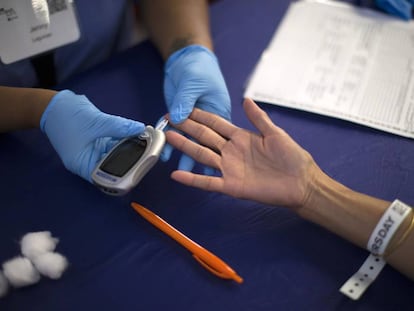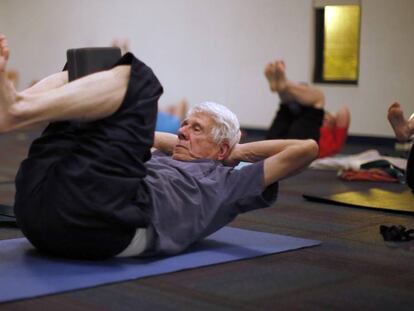How exercise can help you manage diabetes
Regular physical exercise can reduce the risk of complications associated with the disease

Being diagnosed with type 2 diabetes is a wake-up call to take better care of yourself. One way to do this is with physical activity. Increasing movement throughout the day will help you feel better and best of all, reduces the risk of common complications associated with diabetes. These include problems with your kidneys, feet, nerves, eyes and heart. In addition to regular exercise, a person diagnosed with type 2 diabetes should also maintain a balanced diet and keep their blood glucose levels at a healthy level with medication or insulin if necessary.
Consult a doctor before increasing your physical activity
How can exercise help?
Exercise plays an important role in both managing type 2 diabetes and helping to prevent its onset. A modest weight loss of 5% to 7% – about 10 to 15 pounds (four to seven kilos) – in a person who weighs 200 pounds (90 kilos) – can delay and possibly prevent type 2 diabetes. Research has shown physical activity can also do the following:
- Lower blood glucose and blood pressure
- Lower bad cholesterol (LDL) and raise good cholesterol (HDL)
- Improve the body’s ability to use insulin
- Lower risk for heart disease and stroke
- Keep the heart and bones strong
- Keeps joints flexible
- Lowers risk of falls
- Helps with weight loss
- Reduces body fat
- Increases energy levels
- Reduces stress
What types of physical activity can help?
There are four kinds of activity that can help:
1. Incidental exercise. Try to find ways to incorporate extra movements or activity into your day. This will help increase the number of calories you burn. Examples of incidental exercise include:
- Walking around while talking on the phone
- Playing active games with your kids or grandchildren
- Taking the dog for a walk
- Working in the garden
- Cleaning the house
- Taking the stairs instead of an elevator
- Stretching or walking around during a break at work
2. Aerobic exercise. Aerobic exercise requires the use of large muscles and makes the heart beat faster. Aim to work out for at least 30 minutes a day, every day of the week. If it’s been a while since you last exercised, consult your doctor first to make sure it’s fine to increase your physical activity. Aerobic exercise includes:
- Brisk walks
- Hiking
- Climbing stairs
- Swimming or water-aerobics classes
- Dancing
- Riding a bike outdoors or a stationary bike indoors
- Aerobics classes
- Tennis
3. Strength training. Lifting hand weights or using weight machines will build and retain muscle mass. Having more muscle and less fat means more calories are burned even when you are resting. Strength training improves balance and coordination and improves bone health. Strength training can be done with a personal trainer to help you correct your form.
4. Stretching. Stretching increases flexibility, lower stress, and helps prevent muscle soreness. Try to stretch each day to achieve maximum benefits.
Are there types of physical activity that should be avoided?
A person with diabetes who is experiencing complications may need to avoid certain exercises so as not to harm or injure themselves. For instance, lifting heavy weights can increase the pressure in blood vessels in the eye and this may exacerbate conditions like diabetic retinopathy . If you have numbness in your feet – an indication of nerve damage – swimming may be a better option than walking or running.
Can physical activity cause low blood glucose?
Low blood glucose is called hypoglycemia and may occur in people taking insulin or certain types of medications. Low blood sugar can happen while exercising and may cause feelings of shakiness, weakness, confusion, as well as sweating and fatigue.
Make exercise part of your daily routine
While exercise is still important, make sure you follow these steps to prevent hypoglycemia:
- Before exercising, ask your healthcare team if you should be checking your blood glucose.
- During exercise, wear a medical identification bracelet or necklace and make sure to carry ID. Always carry food or glucose tablets in case hypoglycemia occurs. If you plan to exercise for more than an hour, check blood glucose and carry food in case blood sugar drops.
- After physical activity, check blood glucose levels to see how exercise has affected it.
How to stay and keep active
Exercise is important to managing diabetes. The key is to stay on track and make physical activity a regular habit. Find activities you enjoy. If you find yourself making excuses not to exercise, think about why. Do you need to change the activity, is there another time that is more convenient? Keep trying until you find a routine that works for you. Once it’s a habit, you won’t want to do without it.
Dr. Samadi is a board-certified urologic oncologist trained in open and traditional and laparoscopic surgery and is an expert in robotic prostate surgery. He is chairman of urology, chief of robotic surgery at Lenox Hill Hospital. He is a medical contributor for the Fox News Channel’s Medical A-Team. Follow Dr. Samadi on Twitter, Pinterest, SamadiMD.com, davidsamadiwiki, davidsamadibio and Facebook.
Tu suscripción se está usando en otro dispositivo
¿Quieres añadir otro usuario a tu suscripción?
Si continúas leyendo en este dispositivo, no se podrá leer en el otro.
FlechaTu suscripción se está usando en otro dispositivo y solo puedes acceder a EL PAÍS desde un dispositivo a la vez.
Si quieres compartir tu cuenta, cambia tu suscripción a la modalidad Premium, así podrás añadir otro usuario. Cada uno accederá con su propia cuenta de email, lo que os permitirá personalizar vuestra experiencia en EL PAÍS.
¿Tienes una suscripción de empresa? Accede aquí para contratar más cuentas.
En el caso de no saber quién está usando tu cuenta, te recomendamos cambiar tu contraseña aquí.
Si decides continuar compartiendo tu cuenta, este mensaje se mostrará en tu dispositivo y en el de la otra persona que está usando tu cuenta de forma indefinida, afectando a tu experiencia de lectura. Puedes consultar aquí los términos y condiciones de la suscripción digital.
Más información
Archivado En
Últimas noticias
Trump añade su nombre al Kennedy Center, gran centro cultural de Washington, sin contar con el Congreso
El Banco de la República cierra 2025 con la tasa de 9,25% que mantiene desde abril
Guardiola culmina un cierre atípico de campaña: sin mítines y de paseo por pueblos
Las PAU extraordinarias de septiembre en Cataluña se avanzarán a julio en 2027
Lo más visto
- El Supremo condena a ‘Okdiario’ y a Eduardo Inda por intromisión en el honor de Iglesias al acusarle de cobrar de Venezuela
- Los pagos del Gobierno de Ayuso a Quirón engordan con facturas de hace una década y sin pagar desde tiempos de Cifuentes
- Más de 40 congresistas demócratas piden por carta a Trump que cese en sus “intentos de socavar la democracia en Brasil”
- Los hijos de Isak Andic negocian un acuerdo para pagar 27 millones a la pareja del empresario y cerrar el conflicto por el legado
- Irene Escolar: “Si la gente se droga es porque encuentra en ello una anestesia que necesita. Negarlo es absurdo”






























































